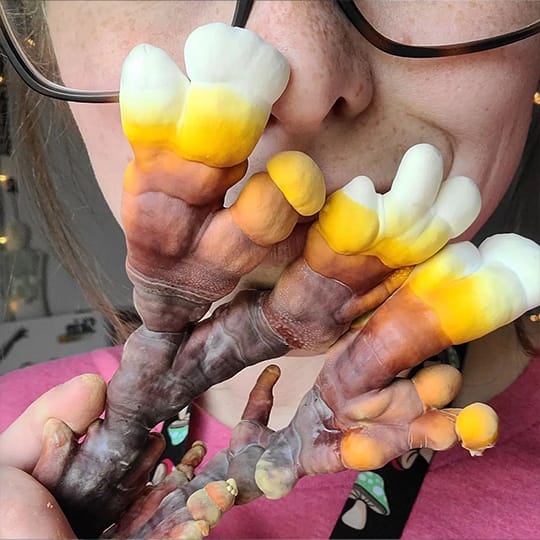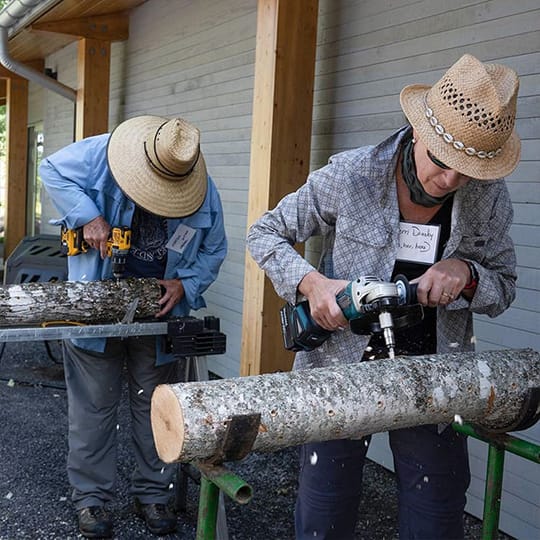- Home
- Organic King Trumpet Mushroom Grow Kit Fruiting Block
Organic King Trumpet Mushroom Grow Kit Fruiting Block












| Skill level | Intermediate |
| Grow location | Indoors |
| Grow speed | 2 to 3 weeks |
| Shelf life | 6 months (refrigerated) |
| Kit dimensions | 6in H x 9in W x 6in D |
| Kit weight | 5 lbs |
| Fruiting temps | 50-65°F |
Our king trumpet (Pleurotus eryngii) fruiting block features a strain that produces large flushes of meaty and delicious mushrooms that are earthy, aromatic, and savory. Raw king trumpets, though dense and spongy in texture, lack aroma and flavor. But when cooked, they come to life with a soft crunchy texture and a mild savory umami flavor reminiscent of abalone.
Unlike other oyster varieties, king trumpets can be more difficult because they prefer cooler temperatures and are prone to drying out or stopping their growth if humidity is not maintained in the early stages. Additionally, king trumpets do not reliably produce second flushes, but may if temperature and humidity conditions are well controlled. Therefore, they are recommended for more advanced growers.
“5 of the Best King Oyster Mushroom Recipes”
"How to Use a Mushroom Fruiting Block Kit"
Upon receiving your kit:
Remove kit from the shipping box as soon as possible. Then, unfold the top of the bag, making room for air space. It's also important to check and confirm that the filter patch is not obstructed. This will help the organism breathe and continue to thrive until you are ready to grow your fruiting block!
Scroll down for guides on growing, storage, cooking, and more.
-
For the majority of mushroom species, all that is needed to initiate fruiting (or begin the growth cycle) is a change in environmental conditions -- specifically humidity, light, temperature, and changes to oxygen and CO2 levels.
For best results:
We recommend growing your king trumpet block in a fruiting chamber (like a monotub or martha tent) as a controlled environment will decrease the risk of contamination and increase the chances of success.
Creating optimal conditions:
The environmental parameters for king trumpet mushrooms can be found on this page under "Temp, Humidity & CO2 guide" and on page 11 of our fruiting block instruction booklet.
Preparing your block:
Unfold the top of the bag, making room for air space. It's also important to check and confirm that the filter patch is not obstructed.
How to initiate fruiting:
- Make a small (2-3”) cut at the top of the bag under the top seam and place upright in your fruiting chamber.
- Allow the block to pin within the bag.
- If slow to pin, place the bagged block in the refrigerator for approximately eight hours before returning to the fruiting chamber.
- Once pinning has occurred, cut off the top of the bag, leaving sidewalls approximately 4” taller than the block.
- Return to fruiting chamber until ready to harvest.
Special considerations:
King trumpet mushrooms are prone to blotch (dark spots on the fruiting bodies) with excess humidity or direct moisture.
Harvesting your mushrooms:
King trumpet mushrooms are best harvested right before the caps flatten out; good shelf life.
Growing different blocks together:
With some compromise, many different species of mushrooms can be grown together in a fruiting chamber. First, consider the temperature range of the mushrooms you desire to grow, and second, the CO2 sensitivity. Humidity ranges overlap for the majority of species. We encourage you to experiment with many different groupings!
Troubleshooting:
Having issues with unusual growth, stunted growth, or no growth at all? Refer to pages 16-18 in our fruiting block instruction booklet.
-
Temperature 50-65°F | 10-18°C Humidity (Phase 1: Primordia) 95-100% Humidity (Phase 2: Fruitbody) 85-95% CO2 Sensitivity (Phase 1: Primordia) High CO2, keep in bag CO2 Sensitivity (Phase 2: Fruitbody) <2,000 ppm - Primordia - The earliest recognizable stage of fruitbody development. Also known as “baby mushrooms” or “mushroom pins.”
- Fruitbody - A fully grown mushroom, the reproductive structure of the organism in which the spores are produced.
- CO2 sensitivity - When CO2 levels are too high, yields will decrease, stems will become long and stringy, caps will be small, and/or growth will halt.
-
If you don't plan to use immediately, you can refrigerate your block for up to 6 months.
-
"5 of the Best King Trumpet Mushroom Recipes"
King trumpet mushrooms are one of the meatiest oyster varieties and make a great substitute for meat. However, unlike the thick king oyster mushroom, king trumpets have a shorter stem and a larger cap that fans out when fully grown. They are delicious when marinated and grilled and their mild yet savory flavor lends well to many different recipes. When thinly sliced, they will sear nicely in a pan.
-
If you’re going to consume home-grown mushrooms, make sure to cook your fresh mushrooms thoroughly with heat. If it is your first time eating this species, it is best to start with a small amount to check for allergies, even if cooked.
Mushrooms grow spores as they develop. This is a natural means of reproduction. This is when people with allergies or compromised immune systems may want to consider putting fruiting mushroom kits outdoors or in a well-ventilated area. Spores in mushrooms sometimes cause respiratory irritation. In rare cases, spores may also cause irritation for some non-allergic or non-immunocompromised mushroom growers. If you are one of them, it is recommended to reduce the overall spore load by harvesting mushrooms while they are still in their younger growth stages.
You may also like
 i
i i
i- Reviews
- Questions
Thank you for submitting a review!
Your input is very much appreciated. Share it with your friends so they can enjoy it too!
Giant mushrooms
It was so cool watching these grow!
Great Kit!
These grew quickly and were delicious!! Thanks, North Spore!
North Spore
Great photo, Doug! Thanks for sharing!
Pin cushion
I had a little difficulty keeping it cool enough to get it to pin, but now it looks like a big overladen pin cushion, with thousands of pins!
North Spore
Awesome, James! We really appreciate you taking the time to share your experience.
King mushroom
So far its been 10 days its not pinning. I have followed the directions and its moist. It looks good and white so i guess ill give it more time.
North Spore
Thanks for sharing, Jill! Somebody from our team is reaching out to you via email now to assist you.
Not prepared….
Ordering , shipping , and receiving was all good . Definitely a little trickery to work with . I didn’t realize the growth requirements is where to me , I have slightly failed . Temperature was one aspect and CO2 was another . I have a grow tent in my garage which temps are cooler . I placed a jug of egg shells and vinegar (making material for organic gardening) which is producing CO2 . Have little pins starting to form now . Have strawberry starts in pots which hoping hold some humidity to the senario . Wanted to try these because the do taste real good but guess , should have done some home work and been a little more prepared . Still hopeful will get something going , not giving up yet . It’s all a learning experience .
North Spore
Thanks for sharing, Michael! We really appreciate your support. If you need help with anything, please reach out!














